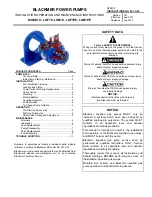
G.
REFRIGERANT CIRCUIT
Inspect all refrigerant tubing connections and the unit base for oil
accumulations annually. Detecting oil generally indicates a refrig-
erant leak.
WARNING:
System under pressure. Relieve pressure
and recover all refrigerant before system repair or final
unit disposal to avoid personal injury or death. Use all
service ports and open all flow-control devices, including
solenoid valves.
If oil is detected or if low cooling performance is suspected,
leak-test all refrigerant tubing using an electronic leak-detector,
halide torch, or liquid-soap solution. If a refrigerant leak is
detected, refer to Check for Refrigerant Leaks section.
If no refrigerant leaks are found and low cooling performance is
suspected, refer to Checking and Adjusting Refrigerant Charge
section.
H.
INDOOR AIRFLOW
The heating and/or cooling air-flow does not require checking
unless improper performance is suspected. If a problem exists, be
sure that all supply- and return-air grilles are open and free from
obstructions, and that the air filter is clean. When necessary, refer
to Indoor Airflow and Airflow Adjustments section to check the
system airflow.
I.
METERING DEVICE — ACUTROL DEVICE
This unit uses metering devices that are of the fixed orifice type
(located in the header to the indoor and outdoor coils).
J.
LIQUID LINE STRAINER
The liquid line strainer (to protect metering device) is made of wire
mesh and located in the liquid line on the inlet side of the metering
device.
TROUBLESHOOTING
Use the Troubleshooting–Cooling & Heating guide (see Table 14)
if problems occur with these units.
START-UP CHECKLIST
Use the Start-Up checklist to ensure proper start-up procedures are
followed.
Fig. 31—Typical Heat Pump Operation-Cooling Mode
C95044
STRAINER
ACCUMULA
T
OR
COMPRESSOR
STRAINER
LCS
OUTDOOR COIL
INDOOR COIL
A
B
D
C
Check Valves
A
Closed
B
Open
C
Closed
D
Open
LEGEND
LCS
Loss of Charge Switch
Acutrol
Metering Device
Check Valve (Arrow indicates direction of flow)
COOLING CYCLE
1. Hot gas from compressor flows through the 4-way valve and is
directed to the heating liquid line check valve. It is then con-
densed and subcooled through converging circuits. Refrigerant leaves
the outdoor coil by way of the strainer and the check valve in the
cooling liquid line.
2. The refrigerant then feeds the indoor coil through the Acutrol
metering device on each circuit.
3. Each circuit evaporates the refrigerant and the circuits are com-
bined in the indoor coil header with some of the circuits flowing
through the check valve.
4. The refrigerant then flows through the 4-way valve, accumulator,
and back to the compressor.
—29—




































